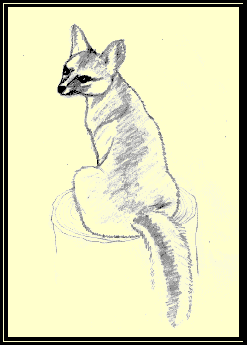
Blue Elderberry
Sambucus mexicana
Blue Elderberry is a large, deep-rooted shrub or small, multitrunked tree with light green leaves. The leaves generally have 7 leaflets and may be anywhere from 4" long in dry areas, to 8" long in wetter ones. The cream-colored flowers occur spring through early summer in our area. They are tiny and arranged in flat-topped groups 3-6" across. These are followed by heavy clusters of small black fruit which are covered in a white bloom making them appear blue. Animals love them and they make great jam, jelly, sauces, syrup and wine. The fresh fruit makes some people nauseous, but drying or cooking the fruit prevents that. Elderberry is semi-deciduous and makes a great garden tree, attracting many birds as well as looking lovely.
The Tongva used "Kuut" in many ways. The flowers were eaten raw or grilled on hot stones. Today, Tongva cooks dip the flowers in a light batter and quickly fry them like Tempura. The Los Angeles Basin Tongva dried and stored the vitamin A and C-rich fruit during the summer for use during the cold, dark days of winter.
The plant had many medicinal uses as well. Older flowers were soaked and the wash used as a soothing skin conditioner. Flowers were also brewed into a tea to treat fever and upset stomachs, and to use as a dental wash. A wash of boiled flowers and leaves was used for wounds and for eye washes, and a thick tea was brewed to sweat out fevers and to clear chest congestion. Aching feet were relieved by a wash made from a mixture of Kuut and Manzanita leaves. Mashed leaves were placed on sores and applied to the nose for nosebleeds. Roots were boiled and mashed and applied to inflammations, and the inner bark was used to produce a strong emetic. Leaves were crushed into a green paste and applied to poison oak infections.
Longer elderberry stems were made into light arrow shafts. Shorter stems were hollowed out and plugged at each end for use as a tobacco container. These were placed in the earlobe as an ornament. The leaves were used to produce a light yellow to green dye, and the twigs and fruits to produce a black dye used in basket making.
Elderberry was widely known as the "Tree of Music", because it was used to make traditional clapper sticks, the best known musical instruments used by the Kumitaraxam, Chumash, and Tongva. It was also used for flutes and whistles after the wood was extensively leached and cleaned.
Cautionary notes: First, since it is a strong purgative, Sambucus mexicana should not be used during pregnancy. Second, do not confuse it with red elderberry (Sambucus racemosa, found mainly along the north coast), which is toxic.

Gray Fox
Urocyon cinereoargenteus
Gray foxes are medium-sized, weighing 7-12 lbs, grayish on top with reddish brown legs and tawny sides. They are white on their throat and cheeks, and along the mid-line of their underside. There is a black patch along each side of their muzzle. The tail has a black tip and a dark stripe on the top. They are found throughout the west and into Texas in brushy areas near woods. One was seen recently behind the manager's apartment at the BFS.
Gray foxes are very good at climbing trees, particularly if there are low-hanging branches, and will do so to escape dogs or people. They are not strictly nocturnal. Although they are much more active at night, they can sometimes be seen foraging in the daytime too. When they see an intruder, they often hide behind vegetation and wait quietly until it passes.
Gray foxes usually make their dens in rock crevices, inunderground burrows, under rocks, in hollow logs, or in hollowtrees, sometimes as high as 30 feet up. They have even been knownto make dens in woodpiles and fields of sorghum!
These foxes are omnivorous and eat small mammals, insects, andbirds in the winter an d sp ring. In late summer and fall, they add fruit and nuts (mostly acorns) and the occasional crayfish.
Breeding begins in December and continues on into March. Between three and six pups are born in April or May. The pups grow rapidly and soon leave to find their own shelter. There is some evidence that where coyotes formerly were numerous, the gray fox is scarce and that, if the coyote population decreases, the gray fox becomes more abundant.
Gray foxes are thought to live six to 10 years in the wild. The main causes of death are predation, parasites, diseases, and, of course, people.